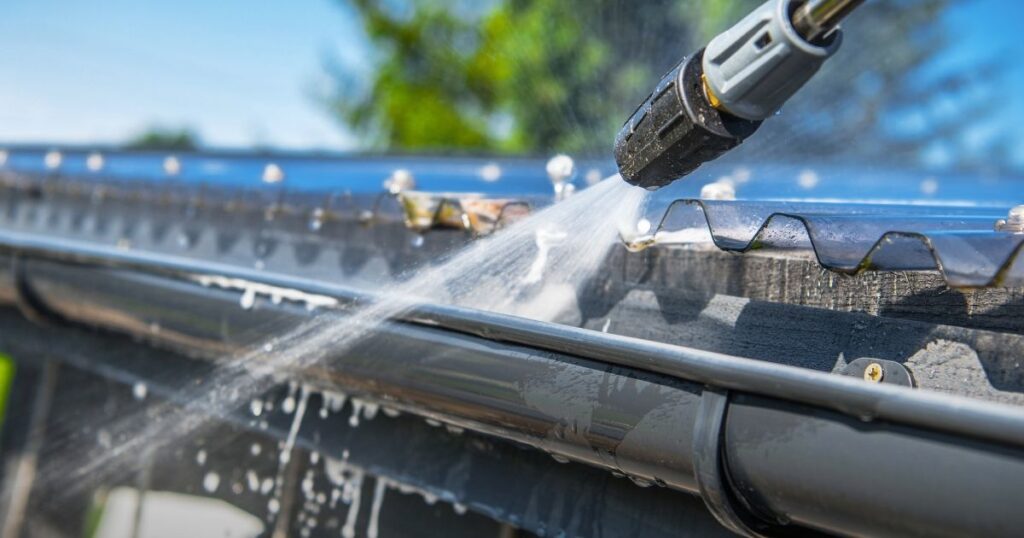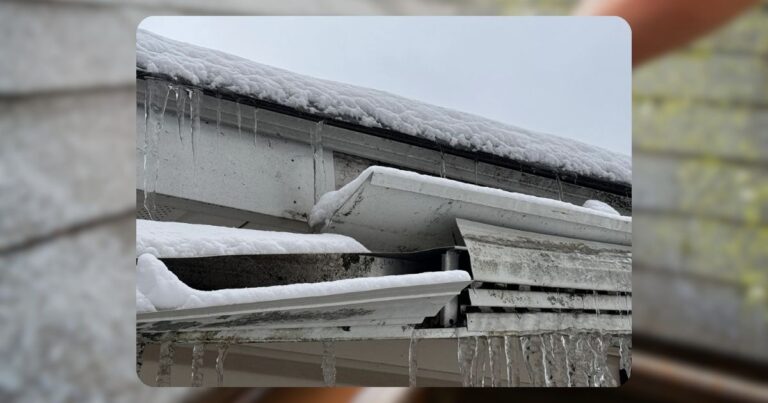Gutters aren’t just part of your home’s trim — they’re your first line of defense against water damage. Every time it rains, they quietly move gallons of water away from your roof, walls, and foundation. But here’s what many homeowners miss: when gutters clog, they stop protecting and start damaging.
Clogged gutters don’t just cause puddles or drips. They create hidden stress points in your home — like slow foundation shifts, rotting fascia boards, or mold creeping into walls. Over time, this leads to problems that aren’t just cosmetic; they’re structural and costly.
Regular gutter cleaning is like preventive care for your house. It’s cheaper to remove leaves and debris twice a year than to pay for foundation repair, roof replacement, or water damage cleanup later. Even small tasks, done on time, can save you thousands.
In this article, we’ll break down why routine gutter cleaning matters, the often-overlooked risks of skipping it, and the smartest ways to keep your home protected year-round — without wasting time or money. Let’s get started.
What Gutters Do and Why They Matter
Gutters are your home’s simple but powerful water control system. Their main job is to collect rainwater from the roof and guide it safely away from your home’s foundation, siding, and landscaping. Without this system, water runs off the roof edge, pooling around your foundation or splashing against walls — setting the stage for damage.
Well-working gutters help protect your foundation by keeping water from seeping into the soil and causing shifts or cracks. They also shield your roof by preventing water backups that can lead to rot, leaks, or shingle damage. On top of that, they help maintain your siding’s condition by stopping dirty runoff from staining or weakening surfaces.
Seasonal changes bring extra pressure. In the fall, leaves and twigs can block the flow. In winter, trapped water may freeze, adding weight that bends gutters or causes ice dams on the roof. Spring and summer storms often push large amounts of water through quickly, testing whether your gutters are clear or overloaded.
By understanding how gutters work across the year, you can see why regular cleaning matters — it’s about preventing small problems before they grow into expensive repairs.
Risks of Neglecting Gutter Cleaning
Clogged gutters may seem minor, but they set off a chain reaction of damage. From roof leaks and cracked foundations to pests, ruined landscaping, and dangerous ice dams, neglecting gutter cleaning can cost you big. Here’s what’s really at stake when you skip this simple task.
Water Damage to Your Home
When gutters clog, water has nowhere to go except over the edges — and that’s where the real trouble starts. Overflowing water can seep under roof shingles, causing leaks and wood rot. The fascia and soffit (the boards along your roof’s edge) absorb that moisture, leading to soft spots, peeling paint, and long-term damage.
Even worse, water pooling near the foundation puts constant pressure on it. Over time, this can crack the foundation or flood your basement, creating expensive repair needs you could have avoided with simple upkeep. Inside the home, moisture sneaking in through cracks or walls creates the perfect setting for mold and mildew, which can spread fast and threaten your air quality.
Pest and Insect Infestations
Clogged gutters hold standing water — an open invitation for mosquitoes, ants, and termites to breed. But it’s not just bugs. The debris itself attracts rodents, birds, and even squirrels, all looking for a place to nest. Once pests settle in, they often look for ways into the house, creating a whole new set of problems.
Landscaping and Exterior Damage
Water spilling over clogged gutters hits the ground hard, washing away soil, mulch, and plants. Over time, this erosion can expose the foundation and kill your landscaping efforts. You might also notice dirt splashing onto your siding, leaving stains or causing long-term damage to the exterior finish, brick, or paint.
Ice Dams and Winter Hazards
In winter, clogged gutters trap melting snow and ice, which then refreezes. This process creates ice dams — heavy, frozen ridges that push under roof shingles, causing leaks and structural stress. The extra weight can pull gutters loose or cause sections to collapse entirely, adding to repair costs and safety risks.
Hidden Costs and Health Risks
Beyond the visible damage, there’s a hidden price. Mold removal, pest control, water damage repairs, and roof work can add up to thousands. Plus, mold spores and pest droppings affect indoor air, putting your family’s health at risk. Regular gutter cleaning is a small investment that protects you from these bigger, more harmful outcomes.
Benefits of Routine Gutter Cleaning
Routine gutter cleaning isn’t just about looks — it’s a smart way to protect your home, health, and wallet. Here’s how this simple task delivers big benefits.

Protects Your Investment
Regular gutter cleaning helps you avoid expensive repairs to your roof, foundation, walls, and yard. By keeping water flowing away from your home, you protect the structure and avoid damage that can drain your savings. It also keeps your home looking cared for, helping maintain property value and curb appeal — key if you plan to sell one day.
Extends Gutter Lifespan
When gutters stay clogged, trapped water and debris speed up rust, corrosion, and sagging. Routine cleaning removes that stress, helping gutters last longer and work better. You’ll save money by getting more years out of your system before needing repairs or replacement.
Prevents Health Risks
Clogged gutters can lead to damp walls, basement leaks, and standing water — all breeding grounds for mold, mildew, and allergens. Regular cleaning cuts down these risks, protecting your home’s air quality and reducing potential health problems for your family.
Saves Time and Hassle Long-Term
While gutter cleaning might feel like a chore, it prevents bigger, more stressful problems later. Fixing a major roof leak or foundation crack takes far more time, money, and effort than a couple of cleanings each year.
Improves Storm Readiness
Clean gutters are better prepared for heavy rain, melting snow, or sudden storms. By keeping the system clear, you help your home handle bad weather without backups or overflow, reducing the chance of sudden water damage.
How Often Should You Clean Your Gutters?
The general rule is simple: clean your gutters twice a year — once in the spring and once in the fall. This keeps them clear of leaves, twigs, and dirt that build up seasonally.
However, some homes need more attention. If you have lots of trees nearby, live in a windy area, or deal with frequent storms, debris can pile up fast. In these cases, you may need to check and clean your gutters more often, sometimes every few months.
It’s also smart to watch for warning signs between cleanings. If you notice water spilling over the sides, gutters pulling away from the roof, or debris poking out, it’s time for an extra check. Staying ahead of these signs helps you catch small problems before they turn into costly repairs.
DIY vs. Hiring a Professional

When DIY Makes Sense
Cleaning gutters yourself can work well if you have a small, single-story home where the roof and gutters are easy to reach with a stable ladder. If you’re comfortable with basic maintenance tasks and have the right tools — like gloves, a scoop, and a garden hose — you can safely handle the job on your own.
When to Call the Pros
For taller homes, steep roofs, or gutters packed with heavy debris, it’s smarter (and safer) to hire professionals. They have the equipment and experience to handle hidden clogs, like those in downspouts or underground drains, without causing damage.
Hiring pros also makes sense if you want more than just cleaning. Many offer inspections, minor repairs, or can install gutter guards to help prevent future buildup. Investing in expert help can save you time, reduce safety risks, and extend the life of your gutter system.
Tips for Maintaining Clean Gutters Year-Round
- Check Downspout Flow
Every few months, run water through your gutters and make sure it flows freely out of the downspouts. A slow trickle may signal hidden clogs or underground blockages that need attention before they back up. - Secure Loose Gutter Sections
Over time, gutter brackets and screws can loosen, causing sagging that traps debris. Check that gutters are firmly attached and slightly sloped toward the downspouts for proper drainage. - Clean the Roof Edge
Clearing off roof debris like pine needles, seed pods, and small branches keeps them from washing into the gutters during the next rain. A roof broom or leaf blower can make this quick and easy. - Redirect Splash Blocks or Extenders
Make sure downspout extensions and splash blocks are in place and pointing away from the foundation. This small step protects your home’s base and stops water from pooling where it shouldn’t. - Record a Seasonal Maintenance Calendar
Mark a calendar or set phone reminders for spring and fall cleanings, plus quick visual checks after heavy storms. Having a schedule helps you stay consistent and catch issues early before they grow into bigger problems.
Conclusion
Routine gutter cleaning isn’t just a maintenance task — it’s a smart, long-term investment in your home’s safety, value, and durability. Clean gutters quietly protect what matters most: your foundation, roof, walls, air quality, and even your landscaping. Skipping it can set off hidden damage that’s far more expensive and stressful to fix later.
Taking action today — whether that means checking your gutters, setting a cleaning schedule, or hiring a professional — puts you in control. It’s one of the simplest ways to protect your home, avoid surprise costs, and keep things running smoothly season after season. A little time now can save you thousands and a lot of headaches down the road.




